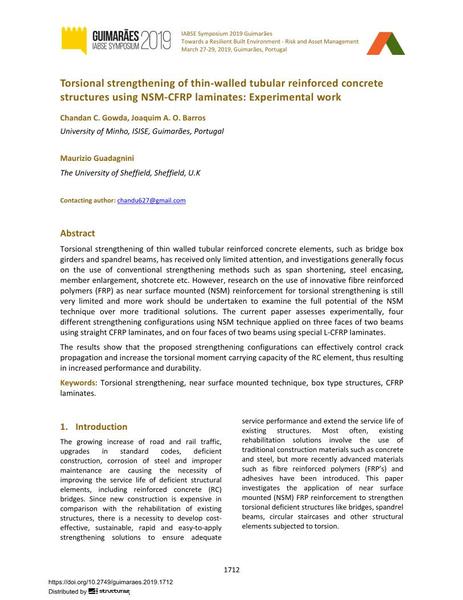Torsional strengthening of thin-walled tubular reinforced concrete structures using NSM-CFRP laminates: Experimental work

|
|
|||||||||||
Bibliographic Details
| Author(s): |
Chandan C. Gowda
(University of Minho, ISISE, Guimarães, Portugal)
Joaquim A. O. Barros (University of Minho, ISISE, Guimarães, Portugal) Maurizio Guadagnini (The University of Sheffield, Sheffield, U.K) |
||||
|---|---|---|---|---|---|
| Medium: | conference paper | ||||
| Language(s): | English | ||||
| Conference: | IABSE Symposium: Towards a Resilient Built Environment Risk and Asset Management, Guimarães, Portugal, 27-29 March 2019 | ||||
| Published in: | IABSE Symposium Guimarães 2019 | ||||
|
|||||
| Page(s): | 1712-1719 | ||||
| Total no. of pages: | 8 | ||||
| DOI: | 10.2749/guimaraes.2019.1712 | ||||
| Abstract: |
Torsional strengthening of thin walled tubular reinforced concrete elements, such as bridge box girders and spandrel beams, has received only limited attention, and investigations generally focus on the use of conventional strengthening methods such as span shortening, steel encasing, member enlargement, shotcrete etc. However, research on the use of innovative fibre reinforced polymers (FRP) as near surface mounted (NSM) reinforcement for torsional strengthening is still very limited and more work should be undertaken to examine the full potential of the NSM technique over more traditional solutions. The current paper assesses experimentally, four different strengthening configurations using NSM technique applied on three faces of two beams using straight CFRP laminates, and on four faces of two beams using special L-CFRP laminates. The results show that the proposed strengthening configurations can effectively control crack propagation and increase the torsional moment carrying capacity of the RC element, thus resulting in increased performance and durability. |
||||
| Keywords: |
CFRP laminates torsional strengthening near surface mounted technique box type structures
|
||||
